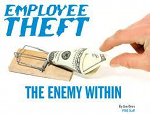Prevent Employee Theft with QuickBooks
April 22, 2013 by Ed Becker
 All businesses, particularly small business are vulnerable to employee theft or embezzlement. It makes sense to ensure that you take steps to minimize and prevent theft opportunities. American businesses loose over $50 billion annually due to employee theft according to the US Department of Commerce.
All businesses, particularly small business are vulnerable to employee theft or embezzlement. It makes sense to ensure that you take steps to minimize and prevent theft opportunities. American businesses loose over $50 billion annually due to employee theft according to the US Department of Commerce.
The first basic rule would be to select your employees after a proper background check. Do not be lazy in this regard. But despite best intentions, thefts occur; using QuickBooks system to prevent misuse by employees is practical and works better.
Keep control of your accounts.
You are the owner, you should be the QuickBooks administrator and the password for your company data file should be known to you only. Too often owners are careless and leave it to their CPA/Pro Advisor; some do not even know the password. What happens when your CPA quits or you have a disagreement with him, he may not surrender the password, and you may even end up having to pay for password retrieval.
You are the owner; retain control of your accounts.
Do not use the Administrator Account
for daily transactions; it is a special account. Use the Administrator Account when checking your monthly figures and as and when required to be used in the single user mode. However for smoother daily transactions you may need to share the password with your CPA or your internal bookkeeper.
Set up the External Account User
– QuickBooks 2009 and later version offer a facility that can create two different External Account Users, one for yourself and one for your accountant’s use. QuickBooks also provides the Client Data Review Tool that helps you keep track of all transactions in your absence in your QuickBooks files.
Create individual User login accounts
for each person who has access to your company data, including yourself, for daily transactions. It is easy to control access to information and mistakes, fraud or theft is easier to pinpoint.
Check your incomings and outgoings
on a weekly basis for payments received and made. If you are checking on a Friday then ask a trusted employee to give you an update the next week on Monday for payments received or made in between.
Make your payments at the periods, weekly or monthly, agreed with your suppliers. If not yourself, designate one person to decide on payments. It will help you avail early payment discounts, etc. Pinpoint responsibility clearly so there is less scope for misuse and theft.
Reconcile your Bank statements
regularly and compare them with QuickBooks account so that irregularities can be easily identified and appropriate action taken.
Carry out physical stock verification
with your QuickBooks figures and make sure they tally. Also assign physical stock and accounting checks to separate individuals in order to minimize employee theft of stock.
Random physical checks
of stocks, cash and bank books will also serve as deterrents and make it clear that you will not accept theft.
Set Closing Dates
on a monthly, quarterly or half yearly basis, whichever is suitable, after the accounts have been reconciled. To find this feature, look in QuickBooks’ Edit menu, the Company Preferences tab, select a date and password and close your accounts as on that date.
 This prevents any accidental change of data or fraudulent tampering of data as only persons who know the password can alter, modify or change data. All authorized changes should be recorded for future reference and easy detection of unauthorized alterations or discrepancies.
This prevents any accidental change of data or fraudulent tampering of data as only persons who know the password can alter, modify or change data. All authorized changes should be recorded for future reference and easy detection of unauthorized alterations or discrepancies.
Inform employees that theft will be taken seriously and they should know the consequences they will have to face of dismissal and legal prosecution.
You do not have to become paranoid and turn your company into a police state. Follow a few sound accounting prevention measures facilitated by QuickBooks. You’ll keep your employees happy and greatly reduce incidences of theft.
Category: CPA




